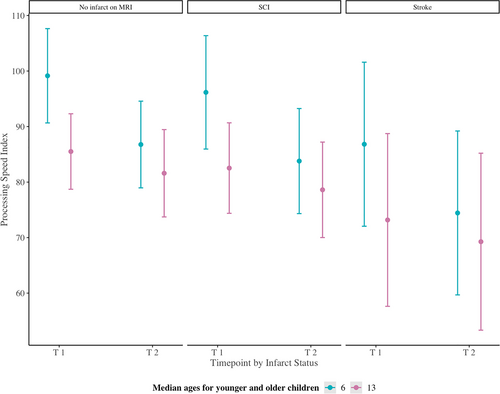S130: PROCESSING SPEED DECLINES OVER TIME IN 4--25-YEAR-OLDS WITH SICKLE CELL DISEASE
Background: Alongside physiological symptoms, young people with sickle cell disease (SCD) may also experience cognitive difficulties, including poorer processing speed. Processing speed develops rapidly from birth to around mid-childhood, with steady improvements thereafter into a person's mid-twenties (Anderson, 2002). Nonetheless, little is known about the dynamic developmental trajectory of processing speed for young people with SCD.
Aims: This study, we aimed to investigate if the change in processing speed index (PSI) over time is significantly different between younger participants (aged under 8.99 years at first assessment) and older participants (over 9 years at first assessment) with SCD.
Methods: One hundred and five participants with SCD aged 4 – 18 (N < 8.99 = 47; N > 9 = 58) at recruitment consented to follow-up IQ assessments (WPPSI-R, WISC-III, WAIS-R or WAIS-III) and MRI scans over two timepoints between 1992 -2003. A repeated measures linear mixed-effects regression model determined longitudinal change in PSI, examining the interaction between age (i.e., under 8.99 years and over 9 years) and timepoint, and controlling for infarct status (i.e., no infarct on MRI, silent infarction, or stroke).
Results: Both younger and older participants experienced a decline in PSI over time, and this decline was largest for younger participants with no infarct. We found a significant main effect of age, F(1, 53) = 4.46, p =. 04 and timepoint, F(1, 27) = 7.86, p =. 009, but no significant effect of infarct status. The interaction between time-point and age approached significance, F(1, 27) = 2.97, p =. 09.
Conclusion: Our findings demonstrated that young people with SCD experienced significant decline in processing speed over time, with a larger decline occurring in participants aged under 9 years, regardless of infarct status. These findings highlight the importance of researching and monitoring PSI longitudinally in young people with SCD, to better understand the impacts of SCD an individual's cognition, identify potential treatment effects and to ensure appropriate support is put in place.
Note: Mean processing speed index in a typically developing sample is 100. SCI = silent cerebral infarction; T1 = timepoint 1; T2 = timepoint 2.

Processing speed index at timepoint 1 and timepoint 2 for participants under 9 (median age 6 years) and over 9 (median age 13 years) years by cerebral infarct status
References
1. Anderson et al, Child Neuropsychology 2002; 8:2




